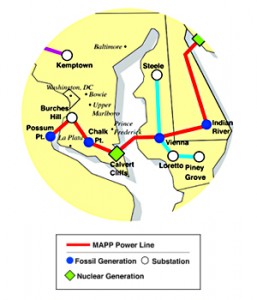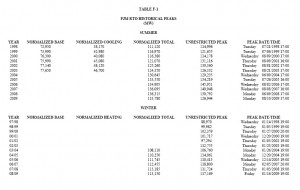PEPCO is Zack’s “Bear of the Day!”
June 30th, 2010
(Just looking for an excuse to trot out that pole-dancing bear!)
BEAR ALERT!!! Couldn’t happen to a more deserving company — Google Alert just sent me notice that one of my “favorite” companies is Zack’s “Bear of the Day!” Why? Well, they specifically mention that MAPP transmission project that just doesn’t seem to be needed:
Bear Of The Day: Pepco Holdings, Inc. (POM)
Check out their individual reports for other utilities and industries. Let’s hear it for the capital market crash — ain’t the depression grand?!?!?!
How bad is it? First the Indian River to Salem leg is cancelled, then the whole thing is suspended… and here we sit… waiting… and we all know that PJM demand is down the toilet.
Click here for the last RTEP Mid-Atlantic subcommittee presentation — see if you can download it!
And they opened an office and now they announce:
Meanwhile, we wait for the RTEP that just won’t come out. How delayed can it get? I guess all that backwards engineering to demonstrate need takes a while, eh?
PJM & PEPCO’s MAPP line trying to appease
May 9th, 2010
The MAPP line, PEPCO’s Mid-Atlantic Power Pathway transmission line project through Maryland and Delaware, is in the news again. But why??? Where the line is not needed, and it’s withdrawn by PJM and PEPCO, why is this being accepted? Why is this regarded as a “win?”
Remember that they pulled the project?
PEPCO letter 1.8.09 to suspend MAPP, includes 1.8.09 letter from PJM’s Herling
And before that, the part from Indian River to Salem was eliminated?
The May, 2009, Press Release says:
According to Gausman, PJM has also reviewed the need for the section of the line that would run from Delmarva Power’s Indian River substation near Millsboro, Del., to Salem, N.J., and has decided to move this portion of the line into its “continuing study” category. This means that the reconfigured MAPP line will now extend approximately 150 miles from northern Virginia, across southern Maryland and the Chesapeake Bay, and terminate at Indian River. The change would likely reduce the total project cost from $1.4 billion to $1.2 billion.
And then there’s the report that shows there’s no need, that demand is downdowndown, that “congestion” is downdowndown, that price of electricity is downdowndown, that demonstrates that the market concept that they’re all drooling over will have them aspirating their aspirations:
So then why did they send out a press release last week:
…which every Peninsula news outlet gave pretty much verbatim coverage?
And then there’s the PJM RTEP 2009, released February 26, 2010.
So here’s how their press release looks after the papers get it:
Delaware utilities: Plan takes power line under Choptank
It is being planned by Pepco Holdings Inc., parent company of Delmarva.
Now read the other “articles” and tell me if there’s an echo in the room:
Underwater power line route suggested
Proposal under Chesapeake avoids refuge
By Calum McKinney • Staff Writer • May 6, 2010
But the day before it was better, with some original quotes:
That line’s going to fall in my living room…
January 24th, 2010
MID-Atlantic Power Pathway and all of PJM’s “backbone” projects in the news:
She’s worried about a larger line rising in the shadow of her house. If the poles somehow get knocked over, “Where’s that line going to fall? That line’s going to fall in my living room.
That’s Farah Morelli’s question. She’s a regular person who woke up one day with a monstrously large transmission line planned literally in her back yard. That’s usually the most effective way to get someone to learn about transmission. It’s a steep learning curve, and what I’ve found in my work with people in the path of proposed transmission is that once they start looking, they find a disturbing fact: Utilities propose transmission lines not because they’re “needed” but that they’re wanted, wanted to increase their ability to transmit and SELL cheap power in areas where it’s higher cost, and make a bundle in the process. It’s not that people don’t have electricity (and high price is the best instigator of conservation), but it’s that people want more and want it cheaper and the utilities which make $$$ from that equation want to make it happen.
HERE’S THE REALITY — The PJM 2010 Load Forecast Report and the Monitoring Analytics “PJM 3Q State of the Market” report show that this market decline isn’t anything new and that it’s not going away anytime soon. The PJM market peaked in 2006:
Today’s News Journal article is a start at pulling it all together, taking a look at the bigger picture, and that bigger picture is what these transmission lines are all about. Three lines were proposed together, the Potomac Allegheny Transmission Highline (PATH), the Mid-Atlantic Power Pathway (MAPP) and the Susquehanna-Roseland line. These aren’t just transmission lines, they’re BIG HONKIN’ ELECTRICAL AUTOBAHNS, quad (or now maybe tri?) bundled 500kV lines. Like WOW. HUGE!
Here’s today’s article:
Lower energy projections put brakes on power lines
DELAY — Susquehanna-Roseland live from the BPU
January 15th, 2010
Fur was flying last night, late when I got a chance to check in, whew…
I’ll be typing notes as we go… we’ll see.
The room is filling up, almost standing room only…
I’ll correct all the typos later…
January 15, 2010
Pledge of allegiance
All five present
Next meeting 1/20 @ 10 a.m.
Special meeting regarding Petition of PSEG re Susquehanna-Roseland line
Ken Sheehan – background – description of project
Jurisdiction
Cost – portion for NJ ratepayers not clear, open issue at FERC
PSE&G claims must be in service by 2012
Extremely complicated
Key questions – need for the project, specifically to resolve reliability problems
Oct 15 2009 – PJM reaffirmed need for PATH, MAPP and S-R
Board became aware of changes in need for PATH line – VA-PATH has asked for withdrawal. Reduction in scope and severity of NERC violqations, PJM will work through planning process
This has raised issue of similar issues with this line
Fiordaliso gave official notice to these issues. PSE&G did not object to entry
Firodaliso also gave official notice re: MAPP suspension. MAPP – PJM said it needed to reanalyze need for MAPP because it assumed PATH
There has been a flurry of comments regarding official notice these last few days. Most notably was two paragraph letter from PJM witness – delays will not in any way change the need for Susquehanna-Roseland.
Intervenors have noted that this conclusory statement needs substantiation.
Fiordaliso has formally recommended that the Board take notice of PATH and MAPP.
Firodaliso – (these guys are talking way too fast)
One word that soood out was flurry. I was the prsiding commissioner. During the proceedings we have held multiple public eharings, held a full evidentiary hearing. We have provided opportunities to prepare Pos Hearing briefs, filed only on 1/6/2010. It was inthese briefs that the PATH and MAPP issues were first raised. Because of the importance of this issue, I felt it was appropriate to bring this to the full Baord. My immediate question, shared by the other commissioners, is whether this information has the ability to significantly change the underlying factual situation of these lines. If PJM is no longer certain that MAPP and PAH are no longer needed at this time. I believe our board would be remiss not to consider whether PJM would feel the same about S-R and how that would affect NJ. The changes to PATH aned MAPP are extraordinary, this is not minor updates and changes (Comm. Fox nods vigorously). One of the core analyhsis of this is need, are the lines needed for the protection of transmission. PJM is able to provide expert analysis. The board would be remiss in not taking this into consideration. PJM has sent a letter that nothing ash changed. (quoting from PJM letter, above is link) “For clarity and in order to avoid any confusion, PJM as the independent transmission authority, that the factors driving PATH and MAPP do not in any way change need for S-R in NJ as detailed in my testimony as set forth in this docket.” We appreciate that input, nevertheless we need more than a this suumary statement. We need to have PJM to explain how they reached that conclusion, and in a way that will allow all parties to comment.
Amend recommendation — recommend to Board that we issue secretary’s letter to PJM asking for their input, notably we should seek and receive detailed confirmation that despite changes in map and path lines no changes have occurred in its analysis tof SF that would materially alter PJM analysis. provide this as soon as possible to allow for our review and provide opportunities for all parties in this case to see the results. This will allow the board to make an informed decision.
I do not want anyone to have the opinion that the board will issue a decision today. One of the obstacles is that the Board may need additional facts, and this is where we currently find ourselves.
Everyone associated with this project has been working as hard as humanly possible to bring this to an efficient and proper conclusion. The size of the record and the significance of this case make it essential that the Commission have a full record and the depth of understanding to understand the positions advanced by all of the parties. This always takes time, with a record as voluminous and contested as this. I hope we can get a commitment from all the commissioners, we can get a commitment to have a decision within 30 days. This time-frame represents a fair balancing of the Board’s responsibilities and the Board’s desire to have this as fair as possible.
Butler:
In my 11 years as commissioner, I’ve learned a few things. Transmission cases are never easy. I also know that I have rarely seen a record this large and with this many parties, and I’ve never seen it decided just 7-8 days of receipt of final briefs. The size of the record, the need to reach a decision, we will give commitment to render that decision. I will be spending part of my holiday reviewing this case! We need to balance needs of community and its residents, take the time, that’s correct approach.
PSEGE called me and informed me Ex PARTE , others commissioners were contacted as well. (all were nodding at this statement). I believe our course of action is the correct one. Asking PJM for formal communication as to how they reached their decision, I am confident it will be a better decision because of the steps we’ve taken today.
Asselta:
I am also in agreement with the presiding Commissioner. I have to tell you that I have not been contacted by any parties. I know a few things that I’m in support of, improving reliability, making sure we have complete reliability, and besides that, economic opportunities, infrastructure improvement so state can grow, I am looking forward to the 30 day deadline, so that the state of NJ will come to conclusion on this decision. I too am looking forward to the reports, make sure this is the right project at the right time and that the ratepayers are not on the hook for every bit of the cost to produce this line. I am in support of Commissioenr Fiordaliso’s request.
Randall:
I agree, I am not prepared to cast vote on this today based on volume of information. I do believe that I will be prepared within the next 30 days.
Fox:
I want to thank follow commissioners and staff for work and thanks to Commissioner Fioredaliso. I’m in strong agreement with Commissioners, record is huge, the transcript is almost 1200 pages, in past , the government has to strive to get it right, for the state and people we represent. Good government requires we take notice of these developments and consider changes in transmission system, failure would be failure to do our jobs correctly. We are not ready to make decision at this time, we just closed record a week ago, and there are significant issues to get into, whether need has evolved, this is not a simple matter, it is not obvious. Resonable minds can and have differed, I’m aware PSEG has a construction schedule, but I am confident that this will not impact their schedule. I’m aware that there’s a FERC deadline, but I believe this action is necessary and propery. We can make this decision within a month. We can maek a final determination in the meantime.
Fiordaliso:
I make a motion, take judicial of information as outlined, and a secretary’[s letter be sent to PJM seeking additional information
Butler:
I second that.
Randall:
I also want to note that we are refirming Commissioner’s 30 day deadline.
Passed unanimously.
++++++++++++++++++++
Here’s the letter they sent, missing the boat…
PEPCO wants to suspend MAPP proceedings
January 8th, 2010
And just now, hot off the press… er… inbox, is notice that PEPCO has asked that the Mid-Atlantic Power Pathway, MAPP, be suspended:
PEPCO letter 1.8.09 to suspend MAPP, includes 1.8.09 letter from PJM’s Herling
They’re saying it’s because MAPP is reliant on PATH in the modeling, but they already withdrew the Indian River to Salem leg and delayed the rest due to LACK OF NEED, and now… well, we know it’s not needed. So whatever, I just wish they’d be honest about it.
Again, remember that all three of these, PATH, MAPP, and Susquehanna-Roseland were promoted based on the 2007 RTEP, which was based on those inflated peak figures from 2006!
Here’s the sensitivity analysis from PATH that is applicable to other projects:
Transmission falling like dominos in a hurricane… I love it when this happens!


